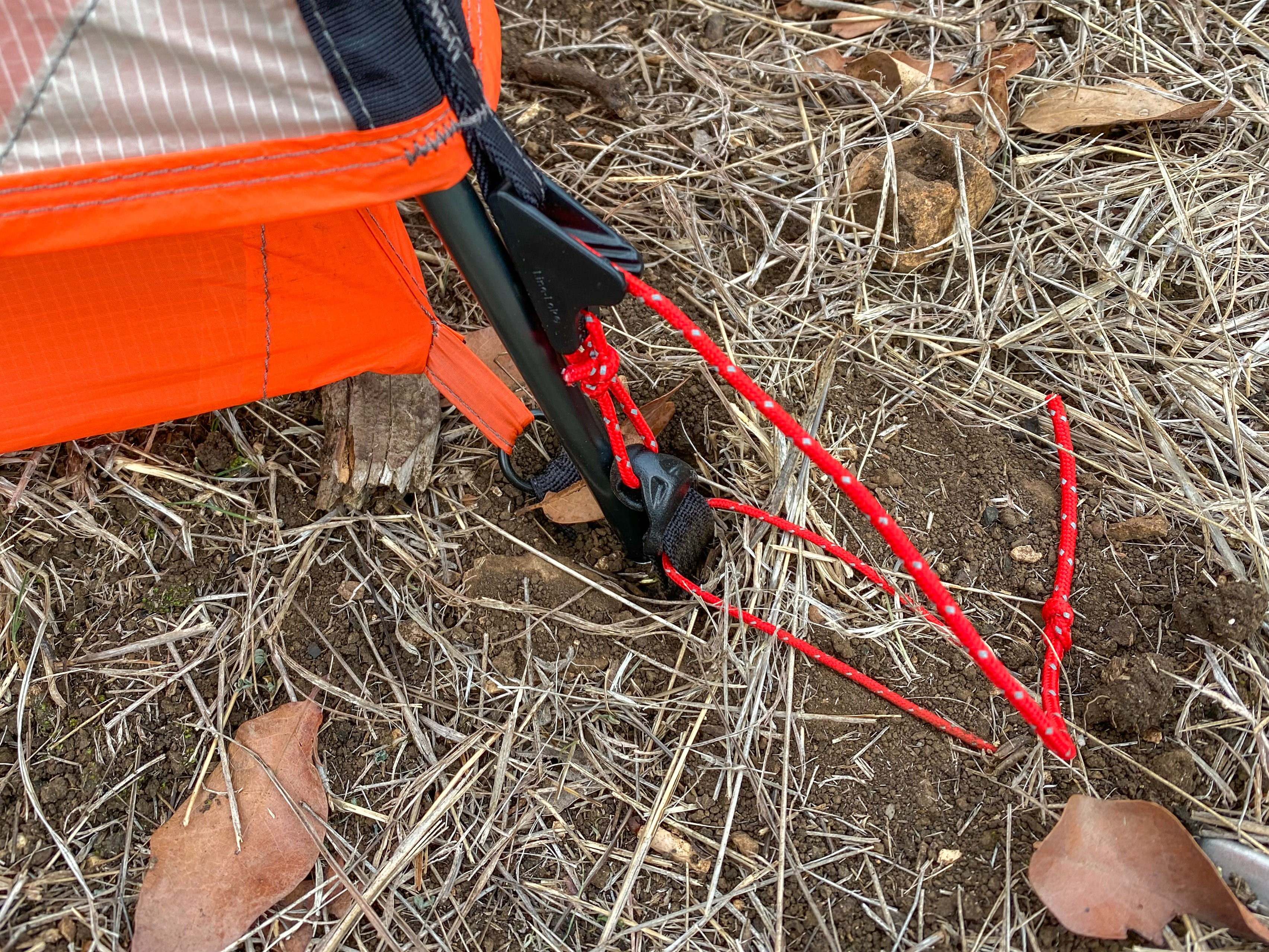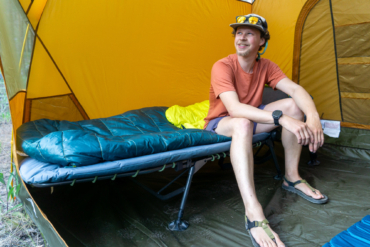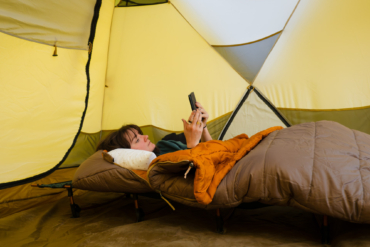The SlingFin Portal is a lightweight, two-person, three-season tent that withstands four-season weather.
SlingFin has designed and produced some of the best-regarded mountaineering tents for a decade from its home base in Berkeley, California.
The brand released the two-person Portal in June 2019 to bridge the gap between ultralight three-season and mountaineering tents. We tested a sample on a multiday winter backpacking trip in Central Texas.
In short: The Portal ($485) is a sub-3-pound, three-season tent with expanded guying options, trekking pole attachments, high-end materials, and other details that truly allow use in winter conditions.
SlingFin Heritage
SlingFin employees own and fund the company, which is spearheaded by people with 30 years of design experience with brands such as Sierra Designs, The North Face, and Mountain Hardwear.
Their unique corporate structure allows product development that is relatively shielded from marketing influences.
An example of this is the brand’s use of a polyether urethane (PE) coating instead of the more typical polyester urethane (PU). PU decreases tear strength and is heavier.
PU also absorbs water, which contributes to losing pitch tension and can lead to mold and mildew, compromising fabric life. This is just one example of how SlingFin bucks popular industry trends.
SlingFin offers an in-depth look at fabric coatings here.
SlingFin Portal Tent Specs
- Verified trail weight: 2 pounds 13 ounces
- Verified packaged weight: 3 pounds 4 ounces
- Floor area: 27.45 sq. ft.
- Interior height: 44″
- Packed size: 14” x 5”
- Floor dimensions: 84” x 51”
- Vestibule area: Two with 8.4 sq. ft. each
- Number of poles: 3
- Number of doors: 2
- Tent body fabric: 15-denier nylon no-see-um mesh
- Floor fabric: 20-denier ripstop nylon PE 1,800 mm
- Fly fabric: 10-denier nylon 66 ripstop Sil/Sil
- Poles: 2 x DAC Featherlite NFL 8.7 mm
- MSRP: $485
- Preinstalled internal guy lines
- 10 external guy points
- 2-side silicone impregnated fly with lap-felled seams (no seam tape required)
- PE-coated floor, seam-taped
- KickStand vents on vestibule doors
- Offset vestibules
- Matching reflective tabs on fly and tent body
- 7 internal pockets
- Pole swivels on long poles (not a hub)
- 2 trekking pole OutRigger attachments
- Can be pitched with footprint and fly only
- Comes with 10 DAC J-Stakes
SlingFin Portal Tent Setup
The SlingFin Portal sets up similarly to other double-wall, freestanding tents.
I staked out the corners, inserted the long poles into grommets and the cross pole into pockets, clipped the tent body, oriented (by aligning reflective tabs) and draped the fly, attached the fly to the poles, and finally guyed out the tent.
There are minor differences with the Portal that became apparent during setup, all of them aimed at increasing stability. The first one I noticed was the use of a pole swivel instead of a hub; this keeps the long poles intact, increasing structural integrity and potential lifespan. Also of note was the choice of proven DAC NFL poles.
A standout feature was the sheer number of fly guy points, 10, and how they adjoin to toggles that attached the fly to the poles. Additionally, the fly is nylon 66 and is doubly treated with silicone, both contributing to higher tear strength and less water retention and sagging.
Another notable addition was the extra zipper sliders on all doors, eliminating the need for repair should one become damaged.
The internal guy lines greatly augmented lateral stability. The upper connection points correspond to the junctions of the tent body to poles, poles to fly, and fly to external guy lines, creating a truss that directs forces to the stakes.
One set of internal guy lines is preinstalled, and another can be easily added; the six extra guy lines can be used both internally and externally.
Finally, the trekking pole OutRiggers; Velcro loops at the end of the cross pole held adjustable trekking poles, functionally creating legs for the cross pole.
Is the SlingFin Portal Tent Stable?
Although conditions were relatively mild during my testing trips, the extreme stability of the Portal was obvious.
Pushing both laterally and vertically on the tent revealed the effectiveness of the internal and external guying systems and the OutRiggers. Duplicating on my backpacking partners’ tents clearly revealed the relative superiority of the Portal’s structural enhancements.
On a few evenings, as the sun dipped low, winds kicked up for a few hours. Sitting inside the tent and observing from the outside again displayed the greater stability of the Portal compared to other tents.
The other tents would be jostling, some flies and sidewalls getting blown out of shape, but the Portal remained virtually unchanged.
Everything about the Portal signaled an almost single-minded approach to stability. Every stakeout point, guy-out point, seam, and material choices, along with the aforementioned details, added to the tent’s ability to withstand the elements.
Employing external guy lines, internal guying, and OutRiggers added to setup time, but they can all be skipped if conditions warrant.
Although I didn’t get to test the Portal in true winter conditions, I would have no qualms about selecting this tent for four-season backpacking. I had total faith in the ability of the tent to withstand both wind and snow loading.
The only reason I wouldn’t choose it for alpine climbing is the mesh canopy gives up some warmth and allows spindrift entry.
Livability
I found the Portal to be one of the more livable tents in the lightweight backpacking category. The 27.5 square feet of floor space and nearly vertical walls weren’t anything out of the ordinary.
Two regular-length pads and bags fit without touching sidewalls and both campers could sit up, also without touching the mesh canopy. I’m 6′ tall, and both the head and foot of my bag had a few inches to spare. What set the Portal apart was the abundance of pockets.
With two head, two side, two ceiling, and one foot pocket, nothing had to be laid on the floor, keeping the entirety of the valuable real estate reserved for the two campers (or, at times, one camper and a big dog).
The dual doors and offset vestibules also added to livability, providing gear storage out of the elements and independent access and exit.
The mesh tent body was very resistant to condensation, but one morning in the 40s with an inversion in place revealed the effectiveness of the two KickStands on the vestibule doors.
I awoke to moisture on the interior surface of the fly. I deployed the two KickStands, and by the time the coffee had been brewed for the group, the condensation had dissipated in the slight breeze.
SlingFin Portal Review: A True 4-Season Tent
There are certainly lighter two-person, double-wall, three-season backpacking tents. I have tested and owned a lot of them, many of which require extreme care.
And when the weather is within certain limits and weight is at the top of the list, I will still pack those types of tents.
But if the weather is at all unpredictable or the trip is during the shoulder seasons or winter, the slight weight penalty of the SlingFin Portal is totally worth the incredible stability, safety, and peace of mind.
The SlingFin Portal notches itself as a quiver-killer for many; it eliminates the need for a dedicated winter tent and it’s much lighter than dedicated four-season models. The only times it wouldn’t be appropriate are alpine missions where spindrift, extreme winds, and extreme cold are issues.
















